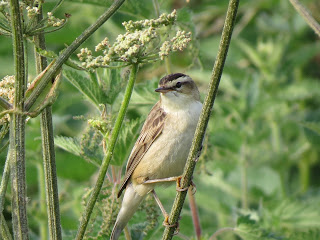16.0°C > 18.5°C: Fine and rather hazy again with thin high cloud. Moderate WNW wind fell away somewhat. Very good visibility
Sunrise: 04:44 BST yet again
Priorslee Lake: 04:19 – 05:40 // 06:45 – 08:20
(80th visit of the year)
Notes from today:
- the Mallard ducklings conundrum: I now believe there was only ever one group of juveniles with the single duck. Until last Sunday there were 4 juveniles; since then only three. The juveniles were large-enough to appear to be safe from most predators, but ....
- a drake Tufted Duck flew in
- the only Grey Heron today was one flying in the distance
- yet another new Coot brood but two other recent broods not located today
- the first 4 Swifts arrived at 04:35 and soon after at least 10 were racing about. Gone by 05:15 and none seen later
- Kingfisher was a new bird for my 2017 Flash list yesterday: today my first since 20 April seen here
- a couple of House Sparrows made it from the estate in to the hedge alongside the academy and hence in to my recording area
- a rather unseasonal Linnet briefly in bushes around the running / cricket field
and
- just 1 moth on the new street lamps – a male White Ermine
- Timothy Tortrix and Common Nettle-tap (Anthophila fabriciana) moths in the vegetation again
- my first-ever Blastobasis adustella (aka Dingy Dowd) moth seen being attacked by a crab spider sp., likely Misumena vatia
- Large Skipper and Ringlet butterflies
- the usual trio of Common Blue, Azure and Blue-tailed Damselflies
- the lacewing Chrysopa perla seen in the vegetation today
- both Episyrphus balteatus and Melanostoma scalare hoverflies identified
- the beetle Rhagonycha fulva, also ‘bloodsucker’ or Hogweed Bonking-beetle
On with the bird totals
Birds noted flying over the lake
- 1 Greylag Goose
- 2 Canada Geese
- 1 Grey Heron
- 2 Lesser Black-backed Gull (singles)
- 17 Feral Pigeons (1 party)
- 4 Wood Pigeons
- 5 Jackdaws
Hirundine etc. counts:
- >10 Swifts
- 2 House Martins again
Warblers counts: number in brackets = singing birds
- 6 (5) Chiffchaffs
- 1 (1) Willow Warbler
- 10 (9) Blackcaps
- 4 (3) Garden Warblers
- 2 (1) Common Whitethroats again
- 2 (0) Sedge Warblers
- 5 (4) Reed Warblers
The counts from the lake area
- 2 + 3 Mute Swans
- 17 (14♂) + 3 (1 brood) Mallard
- 1 (1♂) Tufted Duck
- 6 + 2 (1 brood) Great Crested Grebes
- 4 + 3 (1 brood) Moorhens
- 26 + 6 (5 broods) Coots
A slight salmon-pink start to the sunrise.
Slightly more impressive later.
Too much high cloud to colour properly.
Great Crested Grebe of course.
Another view of Great Crested Grebe with the sunrise effect on the water.
From this angle we see the darker crown above the broad supercilium.
The supercilium extends well behind the eye.
The rather rounded tail is seen here.
... but can be spread!
A clear shot of a Ringlet butterfly today.
Better than the flash shot on the street-lamp yesterday: here is the lacewing Chrysopa perla.
(Ed Wilson)
------------------------------------------------------------------------------------------------------
The Flash: 05:50 – 06:35
(61st visit of the year)
Notes from here
- the number of geese increased again: neither of the hybrid geese noted. The birds are probably gathering to moult – like all geese and ducks they moult their flight feathers at more or less the same time and so are more or less flightless. They find the island a safe haven at this time
- exactly how many juvenile Moorhens and Coots there are is hard to say as adults were still brooding some birds. At least one new brood of Coots today; conversely another brood seems to have disappeared
- the Kingfisher again
and
- Self-heal (Prunella vulgaris) flowering at the N end – a plant I have yet to find at the lake
Birds noted flying over
None
Hirundine etc. counts
- 8 Swifts again
- 4 House Martins
Warblers counts: number in brackets = singing birds
- 3 (2) Chiffchaffs
- 2 (2) Blackcaps
The counts from the water
- 2 + 7 Mute Swans
- 36 Greylag Geese
- 213 Canada Geese
- 1 white feral goose
- 10 (9♂) Mallard
- 4 (2♂) Tufted Ducks
- 1 Great Crested Grebe still
- 2 + >3 (2 broods) Moorhens
- 16 + >5 (>3 broods) Coots
The flowers of Self-heal (Prunella vulgaris).
Of interest between the lake and The Flash today
- the usual Chiffchaff singing around the lower pool
- two Blackcaps started singing near the lower pool – both at locations not used for weeks
and
- Harlequin Ladybird larva
(Ed Wilson)
------------------------------------------------------------------------------------------------------
On this day..........
2009
Priorslee Lake
A pair of Siskins
(Ed Wilson)
2008
Priorslee Lake
A drake Ruddy Duck
(Ed Wilson)
Priorslee Lake
A pair of Siskins
(Ed Wilson)
2008
Priorslee Lake
A drake Ruddy Duck
(Ed Wilson)
















